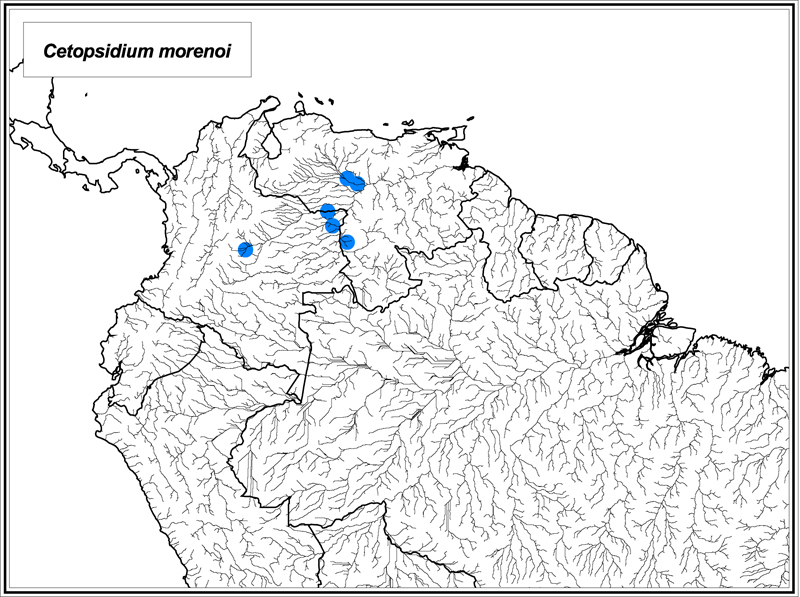


Cetopsidium morenoi (Fernandez-Yopez, 1972)
Identification: Cetopsidium morenoi differs from C. ferreirai in the distal prolongations of the first rays on the dorsal and pectoral fins (present in at least some, presumably mature males, versus absent in all specimens, respectively), in the overall form of the head (with well-developed, distinctly-bulging adductor mandibulae muscles and with the snout not distinctly rounded versus with head less massive due to less extensive development of the adductor mandibulae on the dorsal surface of the head and with snout distinctly rounded, respectively), and in the degree of development of the dark pigmentation on the body (dark pigmentation present over much of the lateral and dorsal surfaces of the body versus the near the absence of dark pigmentation on the lateral surface of the body and with the pigmentation limited to the middorsal region of the body, respectively). Cetopsidium morenoi differs from C. minutum in the length of the pelvic fin (falling short of the anterior limit of the vent versus reaching to the anal-fin origin, respectively) and in the length of the pectoral fin excluding the distal filament of the first fin ray in mature males (falling distinctly short of the vertical through the pelvic-fin insertion versus reaching to that line, respectively). Cetopsidium morenoi differs from C. orientale in the alignment of the dorsal and ventral profiles of the portion of the body posterior of the dorsal fin (converging posteriorly versus running in parallel, respectively) and apparently in the degree of the development and extent of the dark pigmentation on the body (extensive dark pigmentation not extending onto anal fin but with semicircular dark spot at the base of the dorsal fin versus with limited dark pigmentation extending onto the base of the anal fin in at least some specimens and without the dark blotch of pigmentation at the base of the dorsal fin, respectively), the pigmentation of the rayed portion of the caudal fin (absent versus present on at least the basal one-half of fin, respectively), the middorsal pigmentation on the body posterior of the terminus of the dorsal fin (distinct stripe absent versus present, respectively), and the dark pigmentation on the lower jaw (a single, often incomplete, row of chromatophores versus a broad band of chromatophores, respectively). Cetopsidium morenoi differs from C. pemon in the form of the dark pigmentation on the body (formed of large stellate chromatophores versus small, point-like, scattered chromatophores over the dorsal and lateral surfaces of the head), and in the degree of development of the adductor mandibular muscles (very well-developed and distinctly obvious on the dorsolateral portion of head versus moderately-developed and not distinctly obvious externally, respectively). Cetopsidium morenoi differs from C. roae in the location of the vent (located proximate to the base of the anterior most anal-fin ray versus distinctly separated from the base of the anterior most anal-fin ray, respectively), in the alignment of the dorsal and ventral profiles of the portion of the body posterior of the dorsal fin (converging posteriorly versus running in parallel, respectively), and in the form of the dark pigmentation on the body (formed of large, stellate chromatophores versus small, point-like chromatophores scattered over the dorsal and lateral surfaces of the head, respectively). Maximum size: 43 mm SL.
Range: Cetopsidium morenoi is known from the central and western portions of the Rio Orinoco basin in Venezuela and Colombia.
Information from Vari, R. P., C. J. Ferraris Jr. & M. C. C. de Pinna. 2005. The Neotropical whale catfishes (Siluriformes: Cetopsidae: Cetopsinae), a revisionary study. Neotropical Ichthyology 3:127-238.
